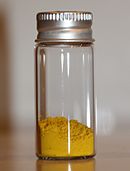Auramine O

| |||
| |||
| Names | |||
|---|---|---|---|
| IUPAC name bis[4-(dimethylamino)phenyl]methaniminium chloride | |||
| Other names auramine hydrochloride, basic yellow 2, pyocatanium aureum, aizen auramine, pyoktanin yellow, canary yellow, pyoktanin, or C.I. 41000 | |||
| Identifiers | |||
3D model (JSmol) |
|||
| ChemSpider | |||
| ECHA InfoCard | 100.017.789 | ||
| EC Number |
| ||
PubChem CID |
|||
| UNII | |||
CompTox Dashboard (EPA) |
|||
| |||
| |||
| Properties | |||
| C17H22ClN3 | |||
| Molar mass | 303.83 g·mol−1 | ||
| Melting point | 267 °C (513 °F; 540 K) | ||
| Hazards | |||
| GHS labelling: | |||
   
| |||
| Danger | |||
| H302, H311, H319, H351, H411 | |||
| P201, P202, P264, P270, P273, P280, P281, P301+P312, P302+P352, P305+P351+P338, P308+P313, P312, P322, P330, P337+P313, P361, P363, P391, P405, P501 | |||
| NFPA 704 (fire diamond) | |||
Except where otherwise noted, data are given for materials in their standard state (at 25 °C [77 °F], 100 kPa). | |||
Auramine O is a diarylmethane dye used as a fluorescent stain. In its pure form, Auramine O appears as yellow needle crystals. It is insoluble in water and soluble in ethanol and DMSO.
Auramine O can be used to stain acid-fast bacteria (e.g. Mycobacterium, where it binds to the mycolic acid in its cell wall) in a way similar to Ziehl–Neelsen stain.[1] It can also be used as a fluorescent version of the Schiff reagent.[2]
Auramine O can be used together with Rhodamine B as the Truant auramine-rhodamine stain for Mycobacterium tuberculosis.[3][4] It can be also used as an antiseptic agent.
References
- ^ Kommareddi S, Abramowsky C, Swinehart G, Hrabak L (1984). "Nontuberculous mycobacterial infections: comparison of the fluorescent auramine-O and Ziehl–Neelsen techniques in tissue diagnosis". Hum Pathol. 15 (11): 1085–9. doi:10.1016/S0046-8177(84)80253-1. PMID 6208117.
- ^ Khavkin T, Kudryavtseva M, Dragunskaya E, et al. (1980). "Fluorescent PAS-reaction study of the epithelium of normal rabbit ileum and after challenge with enterotoxigenic Escherichia coli". Gastroenterology. 78 (4): 782–90. doi:10.1016/0016-5085(80)90684-8. PMID 6986320.
- ^ Truant J, Brett W, Thomas W (1962). "Fluorescence microscopy of tubercle bacilli stained with auramine and rhodamine". Henry Ford Hosp Med Bull. 10: 287–96. PMID 13922644.
- ^ Arrowood M, Sterling C (1989). "Comparison of conventional staining methods and monoclonal antibody-based methods for Cryptosporidium oocyst detection". J Clin Microbiol. 27 (7): 1490–5. doi:10.1128/JCM.27.7.1490-1495.1989. PMC 267601. PMID 2475523.



